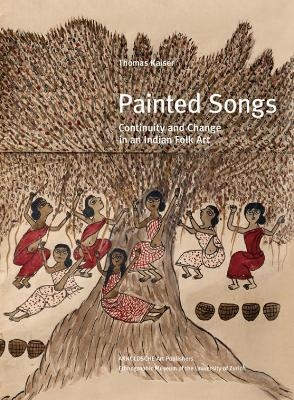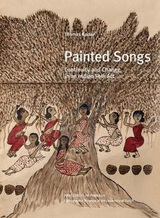Painted Songs
Continuity and Change in Indian Folk Art
Seiten
- Titel ist leider vergriffen;
keine Neuauflage - Artikel merken
On the basis of around 120 picture scrolls, mostly from the second half of the twentieth century, this publication illustrates the transition of patua art from its original function as a vehicle for oral art to a contemporary, visual form of art. It also commemorates the art of jadopatia, which is dying out.
For over 2000 years and until just a few decades ago artists travelled throughout India, using painted picture scrolls to spread stories from the great Indian epics Mahabharata and Ramayana, as well as a wealth of stories about regional Gods and heroes and moral tales, amongst the most illiterate rural population. These
artists were the creators and bearers of an art form which spread from India across East and South-East Asia, as well as in a westerly direction as far as North Africa and southern Europe. In the hands of the painters and singers, the picture scrolls became a portable cinema, projection screens for mythical knowledge and an incentive to listen to the songs whilst looking at the scrolls.
In the same way that other oral art forms have dwindled and lost significance, the picture scroll artists also lost their public and their income. However, in the east of India in West Bengal and Jharkhand two closely related but distinctive picture scroll traditions have been upheld: the patua and the jadopatia. Political
changes, technical innovations and social turmoil brought both these traditions face to face with the necessity to develop new survival strategies too. Whilst the patua rose to the challenge, the jadopatia failed their tradition is coming to an end.
For over 2000 years and until just a few decades ago artists travelled throughout India, using painted picture scrolls to spread stories from the great Indian epics Mahabharata and Ramayana, as well as a wealth of stories about regional Gods and heroes and moral tales, amongst the most illiterate rural population. These
artists were the creators and bearers of an art form which spread from India across East and South-East Asia, as well as in a westerly direction as far as North Africa and southern Europe. In the hands of the painters and singers, the picture scrolls became a portable cinema, projection screens for mythical knowledge and an incentive to listen to the songs whilst looking at the scrolls.
In the same way that other oral art forms have dwindled and lost significance, the picture scroll artists also lost their public and their income. However, in the east of India in West Bengal and Jharkhand two closely related but distinctive picture scroll traditions have been upheld: the patua and the jadopatia. Political
changes, technical innovations and social turmoil brought both these traditions face to face with the necessity to develop new survival strategies too. Whilst the patua rose to the challenge, the jadopatia failed their tradition is coming to an end.
| Erscheint lt. Verlag | 4.9.2012 |
|---|---|
| Verlagsort | Stuttgart |
| Sprache | englisch |
| Maße | 220 x 300 mm |
| Gewicht | 1105 g |
| Einbandart | gebunden |
| Themenwelt | Sozialwissenschaften ► Ethnologie ► Völkerkunde (Naturvölker) |
| Schlagworte | Geschichte • Indien • Indien; Völkerkunde • Jadopatia • Patua • Rollbild • Volkskunst • Wandel |
| ISBN-10 | 3-89790-366-0 / 3897903660 |
| ISBN-13 | 978-3-89790-366-1 / 9783897903661 |
| Zustand | Neuware |
| Haben Sie eine Frage zum Produkt? |
Mehr entdecken
aus dem Bereich
aus dem Bereich
Schweden : Ambiguitäten verhandeln - Tolerieren als soziale und …
Buch | Softcover (2023)
Brill Schöningh (Verlag)
CHF 69,85
Buch | Softcover (2023)
transcript (Verlag)
CHF 75,60




